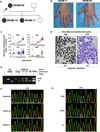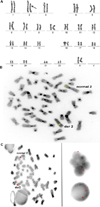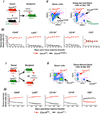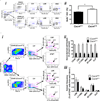Chromothriptic cure of WHIM syndrome
- PMID: 25662009
- PMCID: PMC4329071
- DOI: 10.1016/j.cell.2015.01.014
Chromothriptic cure of WHIM syndrome
Abstract
Chromothripsis is a catastrophic cellular event recently described in cancer in which chromosomes undergo massive deletion and rearrangement. Here, we report a case in which chromothripsis spontaneously cured a patient with WHIM syndrome, an autosomal dominant combined immunodeficiency disease caused by gain-of-function mutation of the chemokine receptor CXCR4. In this patient, deletion of the disease allele, CXCR4(R334X), as well as 163 other genes from one copy of chromosome 2 occurred in a hematopoietic stem cell (HSC) that repopulated the myeloid but not the lymphoid lineage. In competitive mouse bone marrow (BM) transplantation experiments, Cxcr4 haploinsufficiency was sufficient to confer a strong long-term engraftment advantage of donor BM over BM from either wild-type or WHIM syndrome model mice, suggesting a potential mechanism for the patient's cure. Our findings suggest that partial inactivation of CXCR4 may have general utility as a strategy to promote HSC engraftment in transplantation.
Copyright © 2015 Elsevier Inc. All rights reserved.
Conflict of interest statement
A provisional patent on CXCR4 knock down as a method to enhance HSC engraftment has been filed by the US government with DHM, QL, MS, JG, HLM, and PMM as inventors. The authors confirm that there are no other conflicts of interest.
Figures






Similar articles
-
Low-level Cxcr4-haploinsufficient HSC engraftment is sufficient to correct leukopenia in WHIM syndrome mice.JCI Insight. 2019 Dec 19;4(24):e132140. doi: 10.1172/jci.insight.132140. JCI Insight. 2019. PMID: 31687976 Free PMC article.
-
Mechanisms of Sustained Neutrophilia in Patient WHIM-09, Cured of WHIM Syndrome by Chromothripsis.J Clin Immunol. 2018 Jan;38(1):77-87. doi: 10.1007/s10875-017-0457-8. Epub 2017 Nov 24. J Clin Immunol. 2018. PMID: 29177911 Free PMC article.
-
Cxcr4-haploinsufficient bone marrow transplantation corrects leukopenia in an unconditioned WHIM syndrome model.J Clin Invest. 2018 Aug 1;128(8):3312-3318. doi: 10.1172/JCI120375. Epub 2018 Jun 25. J Clin Invest. 2018. PMID: 29715199 Free PMC article.
-
Expanding CXCR4 variant landscape in WHIM syndrome: integrating clinical and functional data for variant interpretation.Front Immunol. 2024 Jul 8;15:1411141. doi: 10.3389/fimmu.2024.1411141. eCollection 2024. Front Immunol. 2024. PMID: 39040098 Free PMC article. Review.
-
Genetics on a WHIM.Br J Haematol. 2014 Jan;164(1):15-23. doi: 10.1111/bjh.12574. Epub 2013 Sep 20. Br J Haematol. 2014. PMID: 24111611 Free PMC article. Review.
Cited by
-
Heterogeneous phenotype of a Chinese Familial WHIM syndrome with CXCR4V340fs gain-of-function mutation.Front Immunol. 2024 Nov 7;15:1460990. doi: 10.3389/fimmu.2024.1460990. eCollection 2024. Front Immunol. 2024. PMID: 39575248 Free PMC article.
-
WBP1L regulates hematopoietic stem cell function and T cell development.Front Immunol. 2024 Nov 1;15:1421512. doi: 10.3389/fimmu.2024.1421512. eCollection 2024. Front Immunol. 2024. PMID: 39555063 Free PMC article.
-
Xolremdi (Mavorixafor): a breakthrough in WHIM syndrome treatment - unraveling efficacy and safety in a rare disease frontier.Ann Med Surg (Lond). 2024 Sep 24;86(11):6381-6385. doi: 10.1097/MS9.0000000000002590. eCollection 2024 Nov. Ann Med Surg (Lond). 2024. PMID: 39525797 Free PMC article. No abstract available.
-
Increased Susceptibility of WHIM Mice to Papillomavirus-induced Disease is Dependent upon Immune Cell Dysfunction.PLoS Pathog. 2024 Sep 3;20(9):e1012472. doi: 10.1371/journal.ppat.1012472. eCollection 2024 Sep. PLoS Pathog. 2024. PMID: 39226327 Free PMC article.
-
The complex nature of CXCR4 mutations in WHIM syndrome.Front Immunol. 2024 Jul 5;15:1406532. doi: 10.3389/fimmu.2024.1406532. eCollection 2024. Front Immunol. 2024. PMID: 39035006 Free PMC article. Review.
References
-
- Bachelerie F, Ben-Baruch A, Burkhardt AM, Combadiere C, Farber JM, Graham GJ, Horuk R, Sparre-Ulrich AH, Locati M, Luster AD, et al. International Union of Pharmacology. LXXXIX. Update on the extended family of chemokine receptors and introducing a new nomenclature for atypical chemokine receptors. Pharmacological reviews. 2014;66:1–79. - PMC - PubMed
-
- Balabanian K, Brotin E, Biajoux V, Bouchet-Delbos L, Lainey E, Fenneteau O, Bonnet D, Fiette L, Emilie D, Bachelerie F. Proper desensitization of CXCR4 is required for lymphocyte development and peripheral compartmentalization in mice. Blood. 2012;119:5722–5730. - PubMed
-
- Beaussant Cohen S, Fenneteau O, Plouvier E, Rohrlich PS, Daltroff G, Plantier I, Dupuy A, Kerob D, Beaupain B, Bordigoni P, et al. Description and outcome of a cohort of 8 patients with WHIM syndrome from the French Severe Chronic Neutropenia Registry. Orphanet journal of rare diseases. 2012;7:71. - PMC - PubMed
Publication types
MeSH terms
Substances
Supplementary concepts
Associated data
Grants and funding
LinkOut - more resources
Full Text Sources
Other Literature Sources
Medical
Molecular Biology Databases


